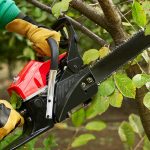 We can give you more than one reason why trimming is integral not only for the health and appearance of your tree but also for your safety. One of the many reasons why it is essential is that when your tree’s branches begin to grow to close to a power line, it becomes a potential threat to you and your family’s safety. Also, if your tree blocks your beautiful view from the window, trimming should be done right away. Whatever the reason for trimming your tree, it must be done correctly to avoid further damage to your tree’s health. It is best to have your trees trimmed yearly to help them thrive for the years to come. Tree trimming does involve basic knowledge about the following to ensure quality results:
We can give you more than one reason why trimming is integral not only for the health and appearance of your tree but also for your safety. One of the many reasons why it is essential is that when your tree’s branches begin to grow to close to a power line, it becomes a potential threat to you and your family’s safety. Also, if your tree blocks your beautiful view from the window, trimming should be done right away. Whatever the reason for trimming your tree, it must be done correctly to avoid further damage to your tree’s health. It is best to have your trees trimmed yearly to help them thrive for the years to come. Tree trimming does involve basic knowledge about the following to ensure quality results:
- Tree species and seasons
- Trimming seasons
- Treating young and old trees
- Equipment required
Trimming Seasons
Every tree specimen is unique, which means every tree requires attention exceptional to its characteristics. There are rules that may apply to one tree, but may be harmful to the other one which is why it is critical to be aware of this before you start trimming back your tree. The general rule of thumb is, oak, sycamores, and willows (shade trees) are ideally pruned in the colder months. On the other hand, blossoming trees such as magnolias and cherry can be pruned in the spring.
Trimming Techniques
You should consider the height of your tree when you perform trimming. In most cases, trees with heavy-set crowns should be trimmed. The two-thirds of the tree’s half consists of the majority of its branches. Be sure to cut above a budding limb when cutting off a branch. Don’t cut too short because it can leave a stub and even cause its premature death. When sawing off a branch, you should take into account the appropriate angle, which is slightly slanted or 45 to 60-degree angle. Trimming at this angle encourages future growth for the tree. Another essential technique is to start with large branches because it will clear your view and make it easier for you to locate smaller branches that need to be trimmed off. Keep the trunk and bark of the tree protected when cutting unwanted limbs because hurting them can cause irreversible damage to the tree.
Accounting for Tree Age
Regardless of the age of your tree, it should be trimmed. Ideally, you should start trimming your tree early on because it serves as training for a better structure and shape. A more mature tree requires less upkeep, but you still have to ensure it has a healthy and strong trunk. Trees in their mid-age are the ones that need the most care. Trim any sprout at the base of your tree because they compete for nutrients that your tree needs to thrive. It can also compromise the structural soundness of your tree’s roots. When your tree matures, you only need to trim dead or weak limbs, and you’re good to go.
Equipment
You will need the basic tools to trim your tree successfully. Loppers, pruning saws, and a ladder are some of the required equipment to trim your tree. Loppers will come in handy when you need to snip off branches at a distant height because it has long handles. If you need to cut a thicker branch, you need to use a pruning saw, which is perfect for the task. Pole pruners are useful for trimming hard-to-reach branches. Its pulley system and saw head allow you to put the tool exactly where you intend to cut the unwanted branch. A ladder is useful when you are unable to reach a branch even with pole pruners. Make sure to have someone to secure the ladder while you climb to avoid unwanted accidents. Once you are done with trimming, clean your tools, and keep them at a dry area to protect them from rust.
Step-By-Step Guide
Nathan, with Wind Tree Service Akron, provides the following steps for proper tree trimming:
Step 1: Plan your action. Find out whether your tree is leaning, too stocky, or growing too near your house or any other fixed structure.
Step 2: Using the pruning saw or loppers, remove any large, unwanted branches. Always wear safety goggles to protect your eyes from debris that fly during the process.
Step 3: Prune with a plan. Any branch that doesn’t add to the beauty and stability of your tree should be eliminated. Always cut at the right angle.
Step 4: Clean the area and keep the branches together with a rope. You can get in touch with a tree removal company to haul the wood away or have them reduced to a size ideal for firewood use.